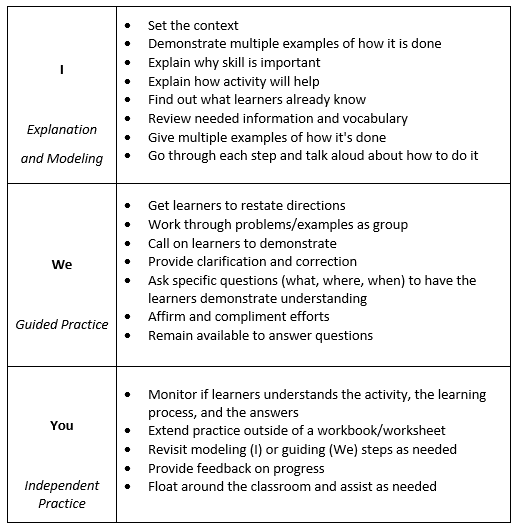- MN ABE Connect
- Archive
- New Free Resource! Teacher Training Toolkit
 May 11, 2019
May 11, 2019
New Free Resource! Teacher Training Toolkit
Andrea Echelberger, ESL Training CoordinatorLooking for easy and fast ways to build the teaching skills of ESL teachers and volunteer tutors? The Teacher Training Toolkit being developed by the Minnesota Literacy Council is a great new resource! Check out the first module of the toolkit at http://mnliteracy.org/TrainingToolkit
Each module in the toolkit will contain a short reading about a teaching practice, a video highlighting the practice in adult ESL classrooms, and discussion questions for the reading and the video. The first module, Giving Directions for Activities, is available now. In this module, teachers learn how to apply the I-We-You method when giving activity instructions. The gradual release of responsibility used in this method provides a straightforward framework for giving directions, improves learner understanding, and increases participation and engagement. Explore the Giving Directions for Activities reading below.
I-We-You Method for Activity Directions
 When introducing a new activity, it’s common for teachers to want to give the directions as quickly as possible so that the learners will have more time to work on the activity. Unfortunately, rushing through the directions can leave many learners unsure of what they are supposed to do. This can result in unhelpful behaviors, such as copying from a neighbor, asking for help in the first language while the teacher is still talking, or waiting for the teacher to come around to repeat the directions to each learner individually.
When introducing a new activity, it’s common for teachers to want to give the directions as quickly as possible so that the learners will have more time to work on the activity. Unfortunately, rushing through the directions can leave many learners unsure of what they are supposed to do. This can result in unhelpful behaviors, such as copying from a neighbor, asking for help in the first language while the teacher is still talking, or waiting for the teacher to come around to repeat the directions to each learner individually.
There is a very simple approach to giving activity directions that will support the learners’ understanding. It’s called the I-We-You method, and it gradually releases responsibility for the activity to the learners. When a teacher uses the I-We-You method for giving group directions, it makes it easier to support learners at all levels and helps cut down on the need for classroom management. This method is a useful tool for planning lessons, because it helps the teacher to think through how they will introduce, model, and check learners’ comprehension during activity directions.
I Do It
The first step in the I-We-You method is “I Do It.” During this step, the focus is on the teacher. The teacher introduces, explains, and models the activity. This step may be very short, particularly for lower level classes with limited listening skills.
We Do It
The second step in the I-We-You method is “We Do It.” During this step, the focus is on the teacher and the learners. The learners do guided practice to demonstrate their understanding of the directions. The teacher asks the learners to give examples, model the activity, and answer questions about the directions. This step is very important and should not be skipped. The “We Do It” step allows the teacher to assess the learners and see if they have the language and understanding needed to work on the activity independently, and provides learners with the repetition that is necessary for understanding. If the teacher misses this step, they will frequently have to provide additional explanation to individual learners.
You Do It
The final step in the I-We-You method is “You Do It.” During this step, the focus in on the learners. The learners independently practice the activity in small groups, with a partner, or individually. While the learners work on the activity, the teacher moves around the room, answering questions and supporting learners as needed. If the teacher follows the first two steps, learners generally need much less support during this step of the activity.
Let’s look at an activity that is popular in adult ESL classrooms. First, read the overview of the activity.
The Flyswatter Game
Purpose: to help learners build their skimming and sight word recognition skills
Preparation Time: 5 minutes
Materials Needed: two flyswatters
Procedure:
- Write 15-20 words on the board in random order. The words can be vocabulary from the weekly unit, sight words that learners should know, or a blend of past and current vocabulary words.
- Divide the class into two teams. Have one representative from each team come up and stand in front of the board. Give each one a flyswatter.
- Call out a word from the board. The two learners race to be the first ones to hit the word with their flyswatter. The learner who hits the word first wins a point for their team.
- Play the game until everyone has had a turn, or until all of the words have been called.
Now, let’s look at how the teacher can use the I-We-You method to give the directions for the activity to the learners.
I Do It
- The teacher tells the class that they are going to play a game that will help them to be faster readers.
- The teacher points to and reads each word out loud and has the class repeat it.
- The teacher points to the words in a random order and has the class read them out loud, going faster and faster.
- The teacher says a word out loud and models hitting it with the flyswatter.
- The teacher reviews direction words (left, right, up, down, straight) with the whole class by pointing and having the class say the directions out loud.
We Do It
- The teacher says a word and has the class call out direction words for where to find the word (e.g. “up and left” or “down and straight”).
- The teacher asks the class, “When you hear the word drink what do you do?”
- The teacher asks a learner to volunteer to come to the front of the room, gives them the flyswatter, and has them model hitting some words while the class calls out direction words. The teacher reminds the class to use the English direction words.
- The teacher has two volunteers come up, gives each of them a flyswatter, and has them model racing to hit some words while the class calls out Directions. The teacher reminds the class to use the English direction words.
You Do It
- The teacher divides the class into two teams. Learners from each team come up and race to hit the words. The teacher calls out words, keeps track of points, and makes sure that everyone gets a turn.
Here are some additional suggestions for tasks the teacher can do during each step:

Find the video and discussion questions for the Giving Directions for Activities at http://mnliteracy.org/TrainingToolkit. More modules will be added soon!

Newsletter Signup
Get MN ABE Connect—the official source for ABE events, activities, and resources!
Sign UpArticle Categories
- ABE Foundations/Staff Onboarding
- ACES/Transitions
- Adult Career Pathways
- Assessment
- CCR Standards
- Citizenship
- COVID-19
- Cultural Competency
- Digital Literacy/Northstar
- Disabilities
- Distance Learning/Education
- ELA
- Equity/Inclusion
- ESL
- HSE/Adult Diploma
- Listening
- Math/Numeracy
- Mental Health
- Minnesota ABE
- One-Room Schoolhouse/Multilevel
- Professional Development
- Program Management
- Reading
- Remote Instruction
- Science
- Social Studies
- Speaking/Conversation
- Support Services
- Teaching Strategies
- Technology
- Uncategorized
- Volunteers/Tutors
- Writing